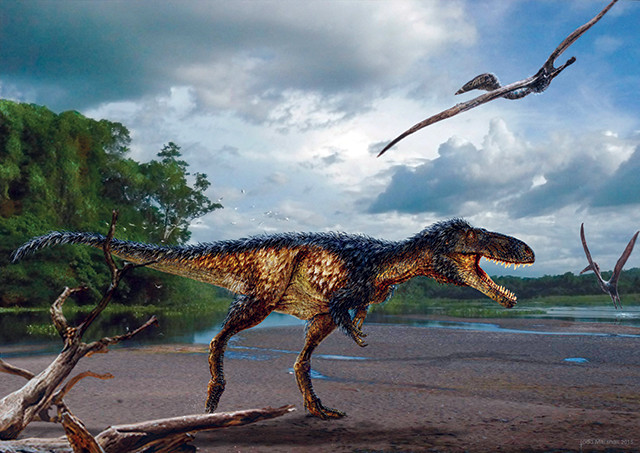
by Lucas Joel Wednesday, June 15, 2016

Fossils of the horse-sized Timurlengia euotica, which lived about 90 million years ago in what is now Uzbekistan, have helped fill a gap in the tyrannosauroid family tree. Credit: Original painting by Todd Marshall.
Tyrannosauroid dinosaurs were the dominant predators of the terrestrial ecosystems in which they roamed for much of the Late Cretaceous, from about 80 million to 66 million years ago. Some, like Tyrannosaurus rex, reached lengths up to about 13 meters and heights of nearly 4 meters. Their large size and keen senses — relatively large nasal passageways suggest a heightened sense of smell — are considered to have been keys to their success.
Many of T. rex’s ancestors, however, were much smaller, with many no bigger than a horse. But how the group evolved from smaller forms into giants has remained a mystery, as few fossils of transitional species have been discovered. In a new study in Proceedings of the National Academy of Sciences, paleontologists describe a previously unknown tyrannosauroid that helps bridge this evolutionary gap.
The dinosaur, named Timurlengia euotica, was unearthed from Cretaceous rocks in Uzbekistan that are about 90 million to 92 million years old. About the size of a horse, T. euotica possessed several features characteristic of later tyrannosauroids, such as an elongated cochlear duct, a structure in the inner ear that “imparts heightened ability to hear lower-frequency sounds [compared to] other theropods, which would have been useful for an apex predator,” wrote lead author Stephen Brusatte of the University of Edinburgh in Scotland and colleagues. “Timurlengia is a long-awaited diagnostic tyrannosauroid from the middle part of the Cretaceous. It indicates that these predators were still far from giants during this time, but had already evolved signature brain and sensory features that may have been tied to the extraordinary success of the last-surviving, [Late] Cretaceous species like Tyrannosaurus.”
© 2008-2021. All rights reserved. Any copying, redistribution or retransmission of any of the contents of this service without the expressed written permission of the American Geosciences Institute is expressly prohibited. Click here for all copyright requests.